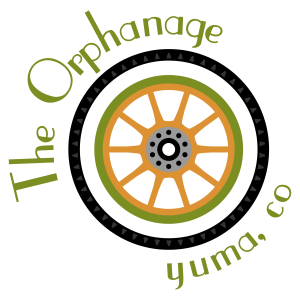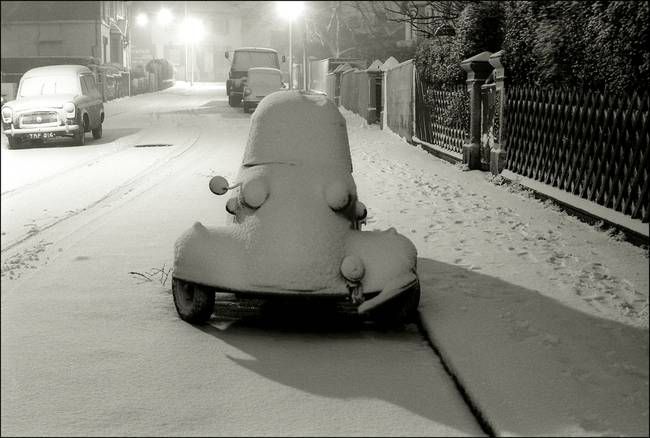1918 American LaFrance Speedster At The Orphanage
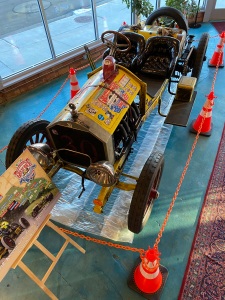
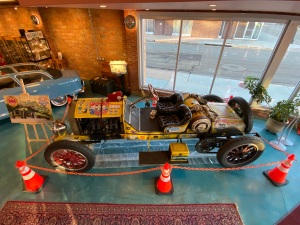
Although it can trace its roots back to 1832, the American LaFrance Fire Engine Company (ALF) was formed in 1903. From 1910 to 1920, ALF produced about 22 touring cars and several speedsters. Because these speedsters were based on the firetruck chassis, several early ALF firetrucks, like the one on display, have been subsequently converted into speedsters. After a run of 111 years ALF declared bankruptcy in 2014.
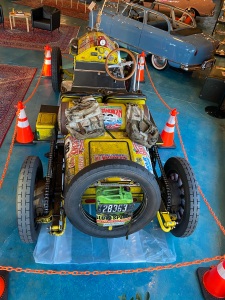
The owners of this ALF Speedster have entered it in The Great Race seven times. The Great race is a time, speed, distance rally, started in 1983, and open to classic cars. It is sponsored by Hemming Motor News and Coker Tire. The ALF Speedster on display at The Orphanage is the poster car for the 2023 race which started in St. Augustine, FL and ended in Colorado Springs.
Power for the ALF Speedster is supplied by the original 9.5-liter, four-cylinder engine. This enormous engine produces a meager 90 hp but an incredible 800 lb-ft of torque. The ALF uses a dual chain drive system to move the rear wheels because, when new, no one knew how to forge a driveshaft that could handle the engine’s torque.
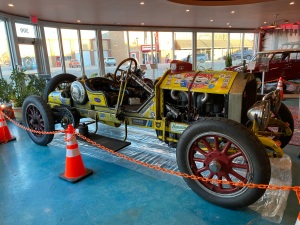
The speedster is also a total-loss oiler. What that means is that all five gallons of oil travel through the crankshaft, out the back of the engine and onto the flywheel where the oil is flung directly at the driver. The Speedster has a handbrake, and no windshield, or doors.
The 1918 American LaFrance Speedster will be on display on the floor of The Orphanage from January 28th through the end of April 2024. The Speedster can be viewed Tuesday through Saturday from 10-4, and Sunday from 1-4, closed Mondays.
Rare 1940 “Sharknose” Graham On Display At The Orphanage
August 2023- November 2023
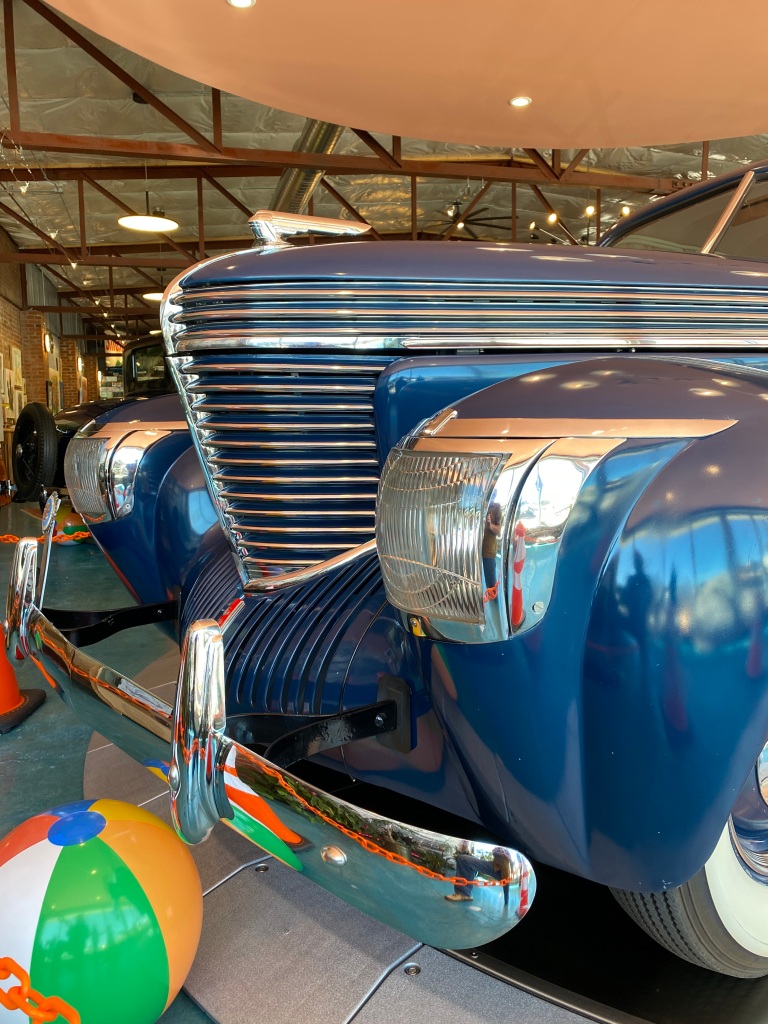
YUMA, COLO – To celebrate the 5th anniversary of The Orphanage, we have borrowed the 1940 Graham Supercharged Custom Model 107, four-door sedan from The Forney collection.
How do three brothers go from manufacturing glass to producing one of the most unconventional, “Streamline Moderne” automobiles ever manufactured? After selling their glass company, brothers Joseph, Robert, and Ray Graham started producing kits to convert Model T Fords into trucks and modify Model TT Fords. The brothers used engines of various manufacturers but settled on Dodge engines which resulted in Dodge acquiring the Graham Brothers firm in 1925.
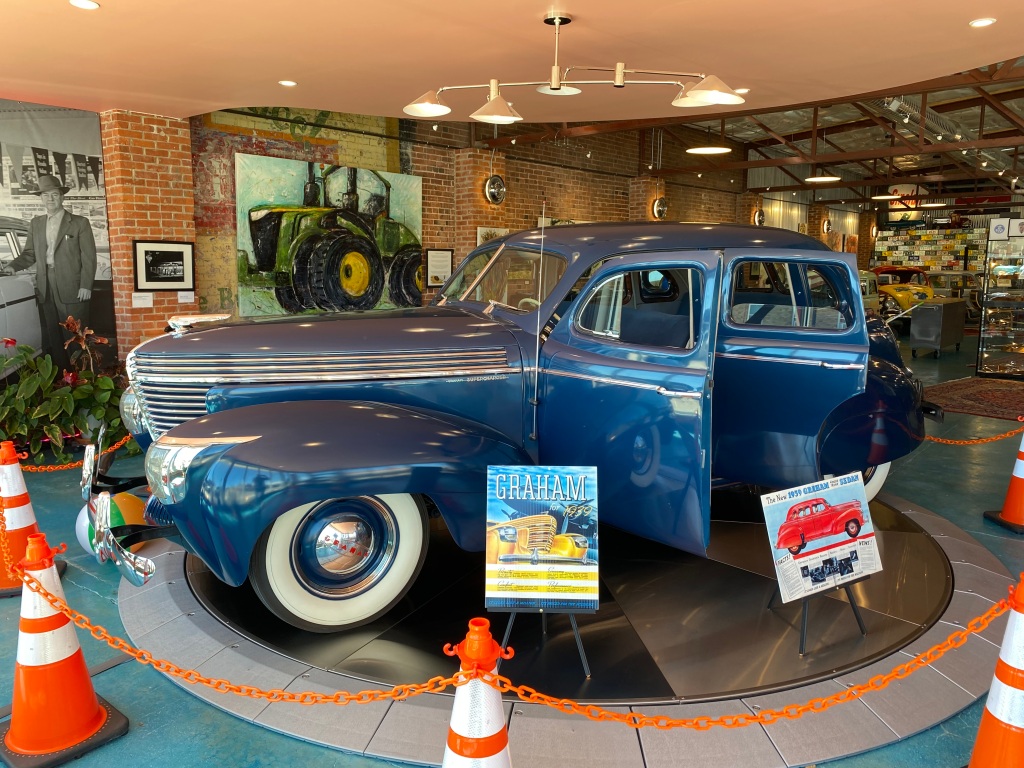
The three brothers were given executive positions at Dodge but decided to strike out on their own in 1927. They purchased the Paige-Detroit Motor Company, for $3.5 million, and Graham-Paige Motors was formed. They fared well at the start of the Great Depression (1929-1939) but as the decade progressed, sales faded.
Desperate for a sales success, the 1938-1940 Graham models took a polarizing design leap. They advertised the new models with the byline “Spirit of Motion.” They looked like they were moving even when standing still. Due to a reverse canted grill and forward thrusting headlights, the car earned the nickname of sharknose Graham.
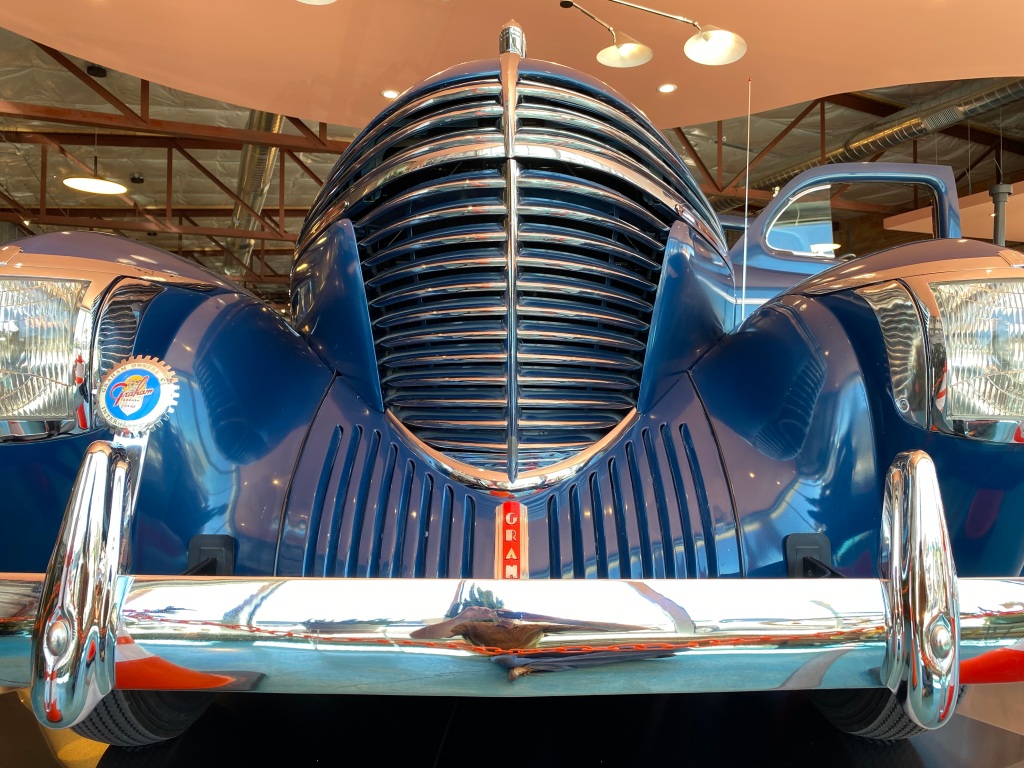
The Graham on display at The Orphanage is powered by a Continental/Graham 218-cu.in., L-head, straight six cylinder engine. The transmission is a column shift 3-speed manual transmission. The car features whitewall tires, an electric clock and heater/defroster. Perhaps the most intriguing option is an intake manifold mounted, belt driven, centrifugal supercharger. The supercharger bumps the normal 93 hp, at 3800 rpm, rating to 120 hp at 4000 rpm. The Graham is painted in “Riviera Blue” and was restored using three different parts cars. The price new was $1,295, equivalent to about $28,275 in 2023.
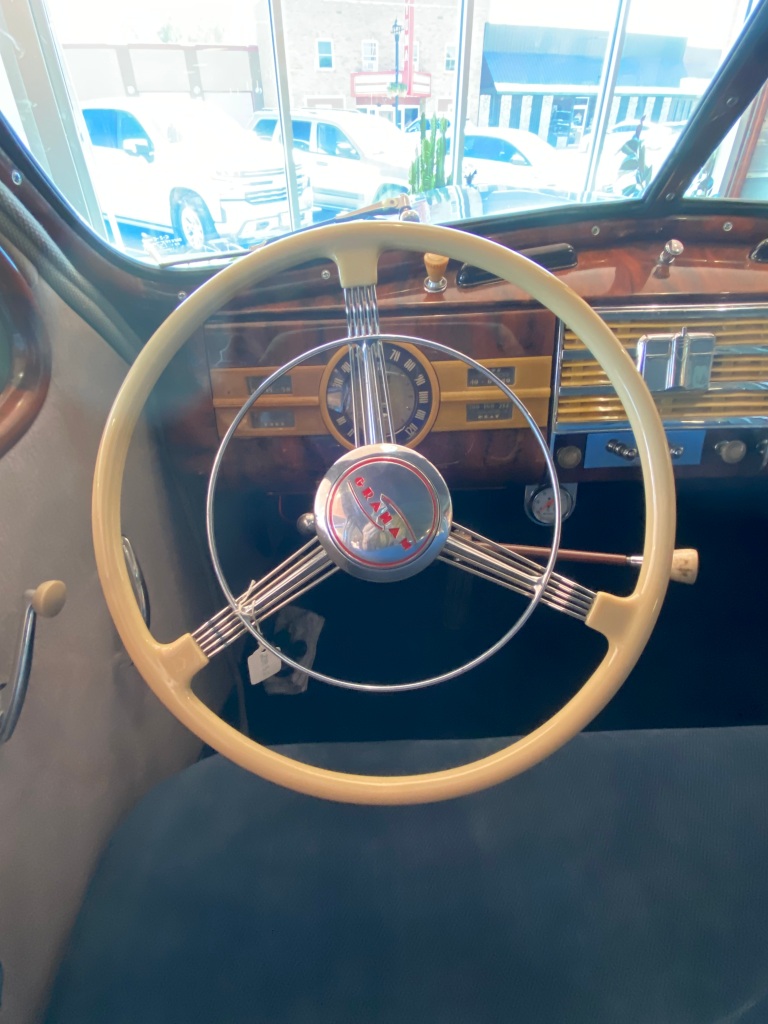
Although it won the prestigious Concours D’Elegance in Paris, France, the “Streamline Moderne” design was not a sales hit. An estimated 1,000 sharknose Grahams were produced for 1940. They were offered in multiple two-door body styles and a four-door sedan. Only about 100 are known to survive today.
Graham’s automobile production ceased in 1940. Its plant reopened for World War II military production and its assets were sold to Kaiser-Frazer in 1947. The 1940 Graham Supercharged Custom Model 107 will be on display on the turntable at The Orphanage until mid-November. Visit the Graham and help us celebrate our 5th year in business on August 19th, from 1-5 pm.
1906 Pope Tribune Roadster Runabout Displayed at the Orphanage in Yuma, on Loan from the Forney Museum
May 2023- August 2023
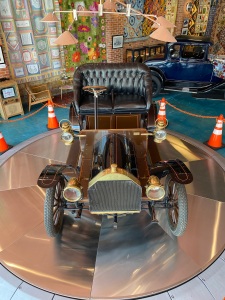
YUMA, COLO – On the turntable at The Orphanage is a 1906 Pope Tribune Roadster Runabout on loan from The Forney Museum of Transportation until mid-August. It sports a front mounted, water cooled, vertical 2-cylinder engine generating 14 horsepower. The headlights used acetylene gas while the side lamps used kerosine. Its price new was $500, equivalent to $16,850.00 in 2023.
Introduced in 1904, the Pope Tribune was a small car designed along European lines and was the least expensive marque in the Pope lineup. Early examples had a one cylinder, 6 horsepower engine, a rear mounted gearbox with two forward speeds and one reverse and braking only on the transmission. For 1905 an improved Model became standard with a fully water-cooled engine encased in a boxy bonnet, rear-wheel mechanical brakes and a gearbox relocated to a central position. Larger cars joined the Tribune’s ranks but the Hagerstown, MD factory never operated at a profit and production of the Pope Tribune ceased in 1908.
The story of the Pope Manufacturing Company is a story of experimentation, bankruptcy, and reorganization. The company was founded, in Boston around 1876, by Colonel Albert Augustus Pope, a veteran of the American Civil War, and incorporated in Hartford, CT in 1877. The intent of the business was to “manufacture and sell air pistols and guns, darning machines, amateur lathes, cigarette rollers and other patented articles.”
In 1878, Pope contracted with the Weed Sewing Machine Company of Hartford, CT to manufacture bicycles, high-wheelers, or penny farthings, under the name of Columbia. The Pope Manufacturing Co. produced the Pope motorcycle between 1902 and 1918 and, later in the 20th century through the late 1980’s, several models of mopeds also under the name of Columbia. To this day, Columbia bicycles are manufactured by Columbia Manufacturing Inc., Westfield, MA.
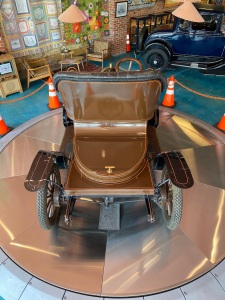
Pope’s first cars were electric and were built, for a short period of time, beginning in 1897. He wanted to focus on the development of electric vehicles because “you can’t get people to sit over an explosion.” The production of gasoline vehicles followed in 1903. The cars produced, spanned a wide range of size and price, including the Pope Waverly, an electric car produced in Indianapolis, IN; the Pope Tribune, an inexpensive brass era car produced in Hagerstown, MD; the Pope Robinson, a luxury touring car produced in Hyde Park, MA; the Pope Hartford, a medium priced touring car produced in Hartford, CT; and the Pope Toledo, a top of the line luxury car produced in Toledo, OH.
After shedding models and companies for years, final production of a Pope model automobile ceased in 1914 when the company went into receivership due to competition from other manufacturers.
Rare 1940 American Bantam Woody on Display at The Orphanage
June 2022- August 2022
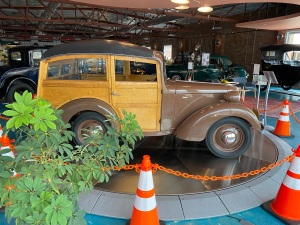
YUMA, COLO – The owner of this 1940 American Bantam woody wagon, John Tuthill of Golden, CO, has allowed The Orphanage to display his rare car for three months. While the Bantam does not belong to The Forney Museum, that is where it permanently resides.
The American Austin Car Company was founded in 1929, in Butler, Pennsylvania, as an American automobile manufacturing corporation producing cars licensed from the British Austin Motor Company. The purpose was to assemble and sell a version of the Austin 7 and call it American Austin. Because of the Great Depression, the company filed for bankruptcy in 1934.
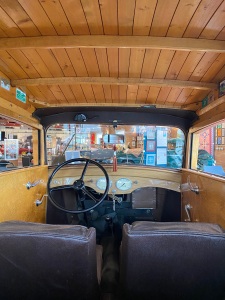
American automobile magnate, Roy Evans, bought the defunct company in 1935 and hired designer Alexis de Sakhnofsky to update the car. Formal connection with Austin UK was severed, although some semblance of a relationship remained. Production resumed in 1937 and continued through early 1941 after 6700 American Bantams, in a variety of body types, were built.
Station wagon chassis, with front end sheet metal, were shipped by truck from the factory in western PA to the Mifflinburg Body Works, in east central PA, where the wooden bodies completed the cars. Only 318 Bantam wagons were built and about 14, in various conditions, are known to exist.
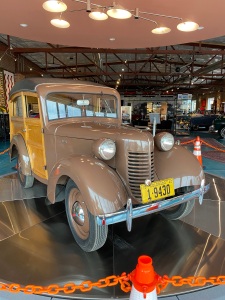
Bantam built their own 4-cylinder engines with cast iron head and block, and aluminum crankcase. By 1940 the engines were almost 50 cubic inches and produced a tire burning 23 horsepower. Bantam used a Warner transmission designed for the smallest Studebaker. The wagon has a 75″ wheelbase and has four wheel cable operated mechanical brakes. The gas tank is in the cowl and just drains into the carburetor. The wagon’s price new was $575.
The Bantam wagon on display was bought new in 1940 from Hadsall Motors, on East Colfax Ave. in Denver, by neighbors of the present owner. It was sold in the 1950’s and found again by John Tuthill in the early 1960’s. There were no options offered for the wagon and all came with black wall tires. The color was named “Golden Beige Metallic” but was actually medium brown metallic. The restoration (the only one of the few remaining wagons considered “factory door” correct) was finished in 1992.
1969 Scampurr on Display at The Orphanage
June 2022- August 2022
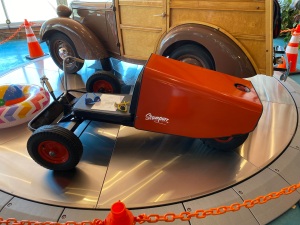
YUMA, COLO – Billed as a “12-month funmobile,” the Scampurr is a combination go-cart and snowmobile. The machine was advertised as “good for trail riding, wilderness exploring, commuting, mushroom picking, cattle and sheep herding, beachcombing, chasing girls and/or dogs, and family fun.”
Scampurr is the 1967 invention of Philip R. Hetland of Moorhead, MN. Hetland was an inventor, golf course developer, and assistant professor of physics at North Dakota State University in Fargo, N.D. Starting in 1968, the Scampurr was produced by Hetland Enterprises, Inc. located in Moorhead, MN., and later, the rights to the multipurpose vehicle were sold to Leisure Industries, Inc. of Edina, MN.
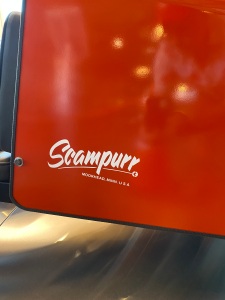
The owner of this Scampurr, Jim Desmith, grew up in Minnesota but presently lives in Colorado Springs. Jim and his brother Paul bought the machine in 1972 for $125.00. It went through six Desmith kids and many of their friends until the clutch became so worn the Scampurr was parked. The correct replacement part could not be found so it was stored in the barn until 2017 when Paul found the correct clutch and belt on Ebay. Paul tore the Kohler motor down and replaced all the worn parts. Jim fabricated a new front frame, seat, and hood. The original steel hood was so beat up that it was flattened and used as a pattern. The previous owner had rigged the hood so that up to three passengers could sit on top of it and with two in the seat, this Scampurr could accommodate up to five riders. Paul lost his battle with cancer and never heard the engine run or saw the completed project.
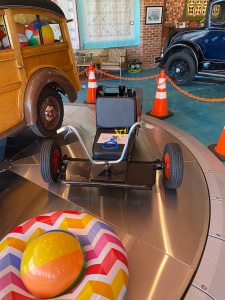
Advertisements stated that a Scampurr can turn a 5’ radius at 30 mph (top speed was 38 mph), but Jim can tell you from experience that you had better be leaning inward hard or it will roll. “We had a Black Lab that would run beside the right front wheel all around the section (four miles) and keep up.” By the end of the summer Buddy could “chase down a jack rabbit even with its evasive maneuvers because he was so conditioned to run four miles at 38 mph.”
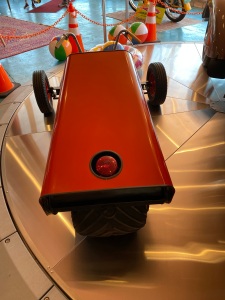
The Scampurr on display sports a Kohler 6 ¼ h.p., 4-cycle engine with a centrifugal clutch, and a dual spring suspension system. The Scampurr could reach a top speed of 38 mph. This machine is the 557th built and the original cost ranged between $628.00 and $797.00. Special introductory packages were offered including the basic unit with front wheels and drive wheel for summer, and ski and snow track for winter.
This 1969 Scampurr will share the turntable at The Orphanage until the end of August. The Orphanage is in downtown Yuma, at 300 South Main Street. For more information about the Scampurr, please contact Richard Birnie at (970) 630-3360, or visit the Orphanage website at orphanageyuma.com.
“In My Merry Oldsmobile”-1903 Curved Dash Olds now on Display at The Orphanage, on loan from the Forney
February 1, 2022- May 1, 2022
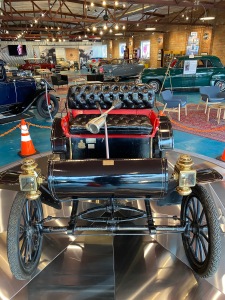
YUMA, COLO – The first mass produced automobile ever made was introduced in 1901 by The Olds Motor Works in Lansing, Michigan and marks the beginning of the large-scale auto industry in the USA. Dubbed the Curved Dash Olds, for obvious reasons, the Model R Runabout was produced through 1907 with three distinct models made, the Model R, from 1901-1903 and into ‘04, Model 6C, 1904 into ’05, and the Model B, from 1905 into 1907. The 1903 Oldsmobile Model R Runabout, from the Forney collection, will be displayed at The Orphanage for three months starting February 1, 2022.
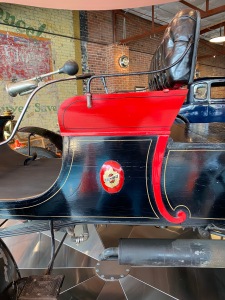
In 1901, 425 curved dash Runabouts were produced. The number produced in 1902 was 2,500, and in 1903, almost 4,000. It is estimated that before production ceased in 1907, over 19,000 curved dash models were built. Between 1902 and 1905 this model was the best-selling car in the country.
Come away with me, Lucille, in my merry Oldsmobile… you know a car is popular when it inspires a song. Slightly suggestive by 1905 standards, In My Merry Oldsmobile was written by Vincent Bryan (lyrics) and Gus Edwards (music) at the height of the Curved Dash Olds popularity. The song was used, over the years, in many movies, television shows and cartoons and was sung by the likes of Bing Crosby, Patti Page, Bill Hayes and Florence Henderson.
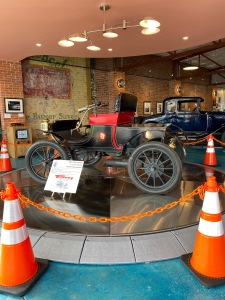
The 1903 Oldsmobile Model R Runabout is a two seater powered by a one-cylinder, ninety-five cubic inch, four-stroke, gasoline powered engine. The transmission is a planetary two-gear, with a center chain drive. Top speed is about twenty mph. Brakes are band within transmission, starting is by a driver’s side hand crank and steering is controlled by a tiller. The price of this car, when new, was $650.00. The average annual income, in 1903, was $489.00.
Buyers had the option of purchasing a dos-à-dos seat (French for back-to-back) to carry an additional adult or two small children. An aftermarket roof and side curtains were also available. Additional equipment on this Model R Runabout is a bulb horn and an emergency brake.
British Invasion at the Orphanage
October 17, 2021-January 15, 2022
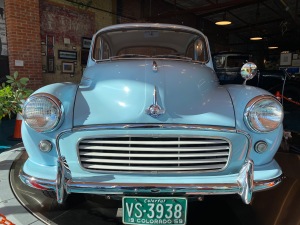
YUMA, COLO – A 1959 Morris Minor 1000 Series automobile will be featured on the turntable at the Orphanage in Yuma. It is on loan from the Forney Museum of Transportation and will be displayed from October 17, 2021, through mid-January 2022.
Morris Motors Limited was established in Britain in 1919 and operated under that name until a merger with The Austin Motor Company Limited in 1952. With that merger, a holding company called The British Motor Corporation (BMC) Limited was formed and both companies kept their separate identities.

This small family car was conceived in 1941 and named Project ‘Mosquito.” Junior Engineer, Alec Issigonis, was lead designer. Development of this car remained a secret throughout the early 1940’s because all resources were expected to be put toward the war effort.
The Morris Minor was built in three different series between 1948 and 1972: the MM Series (1948-1953), the Series II (1952-1956), and the 1000 Series (1956-1971). The car was initially offered as a two-door saloon and convertible and was later expanded to include a four-door saloon, a wood framed estate called the Traveller, and a quarter ton panel van and pickup iterations designed for commercial use. This was the first British car to sell over a million units. Autocar (magazine) called the new Morris Minor “…a primary way Britain got back on the road after the Second World War.”
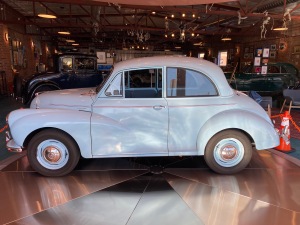
The 1000 Series sported Semaphore-style trafficators, located below the window pillars, which protruded from the bodywork of the car to indicate the driver’s turning intentions. A banjo type steering wheel, dual glove boxes and a round center gauge cluster graced the dashboard. A larger, wrap around, rear window and one piece curved front windshield led to better visibility.
The Morris Minor on display is a water-cooled, front engine, rear wheel drive car with steel, unibody construction. The engine is an in-line 4 cylinder, 948 cc (57.9 cu in) engine with overhead valves. It was said to reach a top speed of 75 mph. Acceleration from 0-60 mph was 31.3 seconds. The transmission is a 4-speed manual. Front suspension is wishbone and torsion bar with semi-elliptic leaf springs in the rear. The car on display was owned by Kim Slemint of Broomfield, CO and was donated to the Forney Museum of Transportation in April 2021.
Rare Willys Pickup at The Orphanage
Mid-July – Mid-October, 2021
YUMA, COLO – Just in time for Old Threshers and Yuma County Fair, the Orphanage has on display a rare, 1938 Willys-Overland, Model 38, ½ ton pickup. The Willys (pronounced Will-is) is on loan from the Forney Museum of Transportation in Denver and will be on display through mid-October 2021.
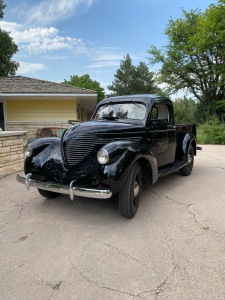
John North Willys purchased the Overland Automotive Division of the Standard Wheel Company in Indianapolis, IN, in 1908 and renamed it Willys-Overland Motor Company soon thereafter. Between 1912 and 1918, Willys-Overland was the second largest manufacturer of automobiles in the U.S. behind Ford Motor Company. In the following years Willys also acquired the Electric Auto-Lite Company of Toledo, OH, the Russell Motor Car Company of Toronto and in 1919 the Duesenberg Motor Company plant in Elizabeth, NJ.
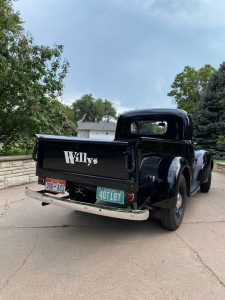
The depressions of the early 1920’s and the 1930’s brought the Willys Corporation to its knees. In the 1920’s, Walter P. Chrysler was hired to sort everything out and many of the Willys assets were sold off to raise money. Several models were discontinued in the depression of the 1930’s.
In 1941 Willys joined Ford to produce over 637,000 Jeeps for World War II and Willys managed to acquire the trademark for the Jeep name by 1950. After the war, Willys concentrated, exclusively, on the production of Jeeps and in 1953, Kaiser Motors purchased Willys-Overland. In 1970, Kaiser-Jeep was sold to American Motor Company (AMC).
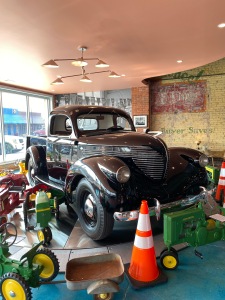
The 1938 Willys on the turntable at the Orphanage reflects a 1937 redesign for their 4-cylinder line. The design was more streamlined, with a slanted windshield, headlamps integrally imbedded into the fenders and a one-piece, rounded hood transversely hinged at the rear.
This pickup sports a 134 cu.in. flathead 4-cylinder, 48 h.p. engine with a Tillotson 1-bbl. carburetor. The transmission is a manual, 3-speed, floor shift. Original equipment included chrome front and rear bumpers; heater; four-wheel mechanical brakes; dual tail lamps; dual interior sun visors; two glove compartments with doors and steel disc wheels. The base price for this ½ ton pickup was $530.00; as equipped, about $580.00.
1907 Maxwell-Briscoe Model ‘RS’ Tourabout visits The Orphanage for three months, on loan from The Forney Museum of Transportation
April 11, 2021 – June 12, 2021
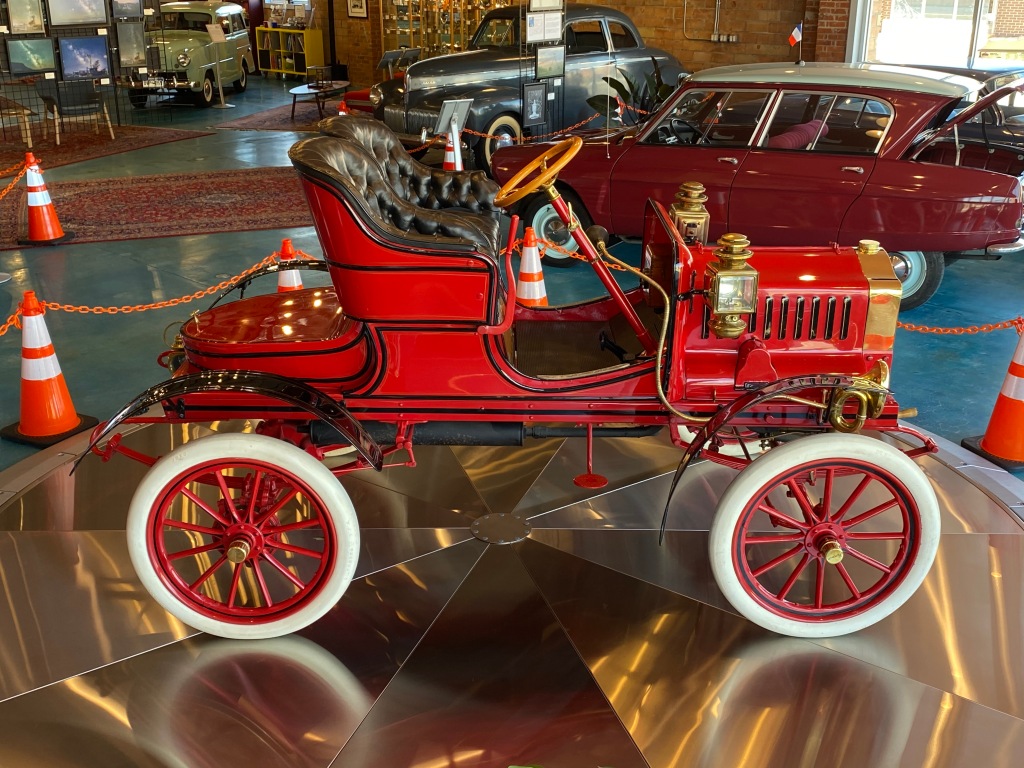
Engine: 127cu.in. Horizontally-Opposed 2-cyl., 14 h.p.; Drip Oil Lubricating System; Thermo-Syphon Cooling System.
Transmission: 2 Forward & 1 Reverse Gear, Hand-Lever Operated Planetary Type
Equipment: Kerosene Lit Brass Headlamps; “Turtle Back” Style Trunk; Hand Crank Start; Brass Bulb Horn w/ Bug Screen; Pedal-Operated External Contracting Brakes on Rear Wheels with Pedal Actuated Parking Brake; External Sparkplug Access.
Price New: $825.00
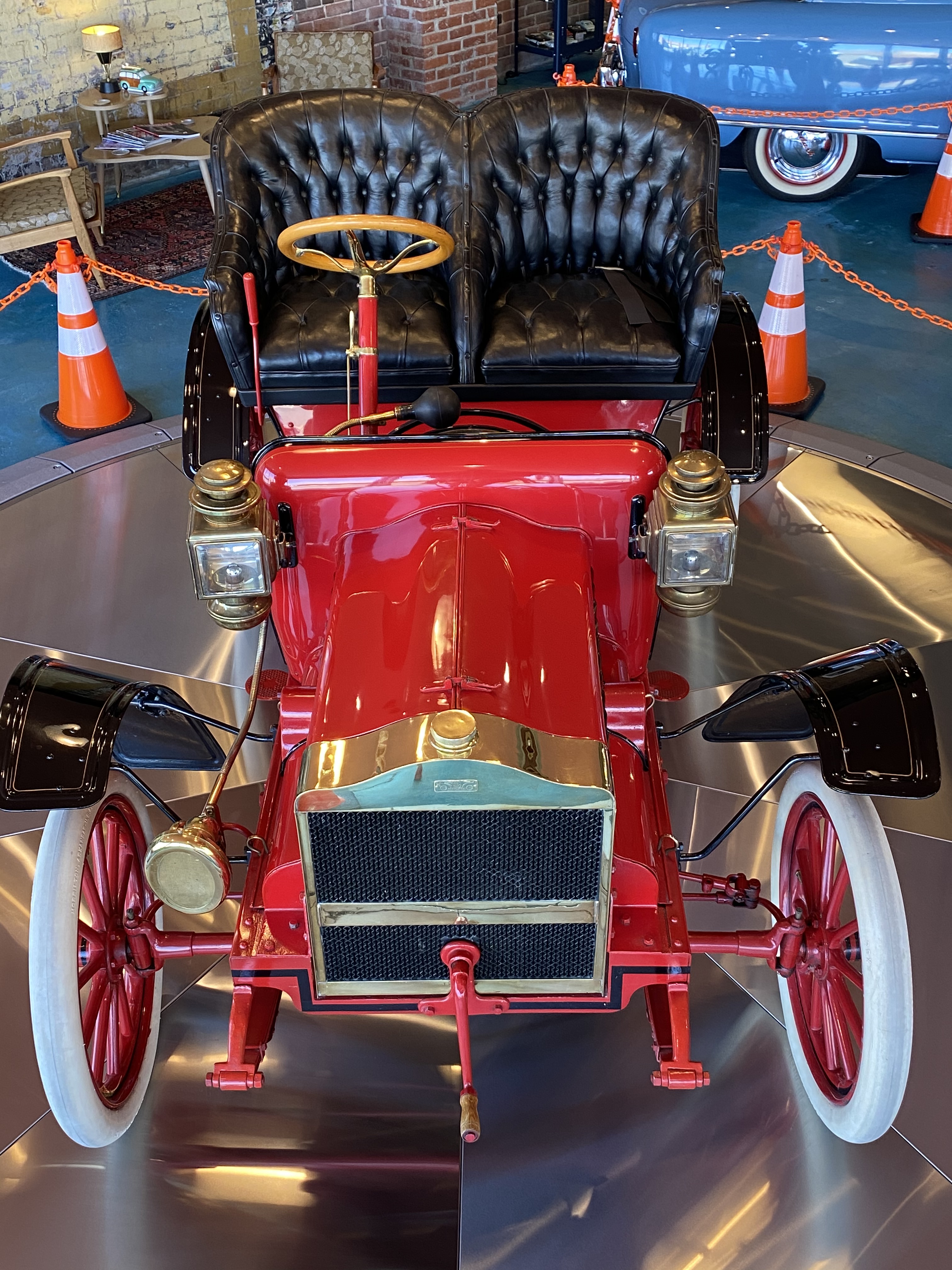
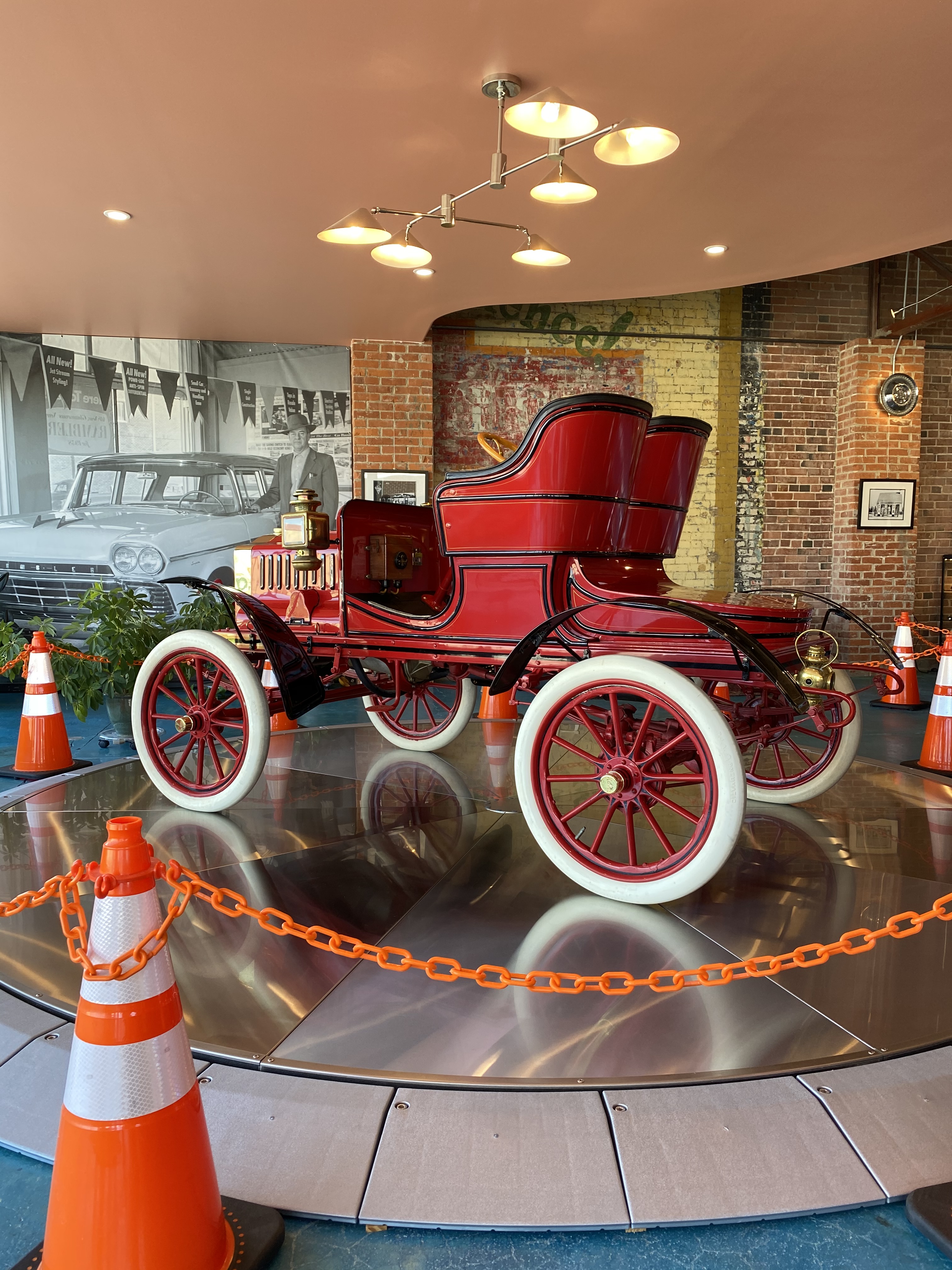
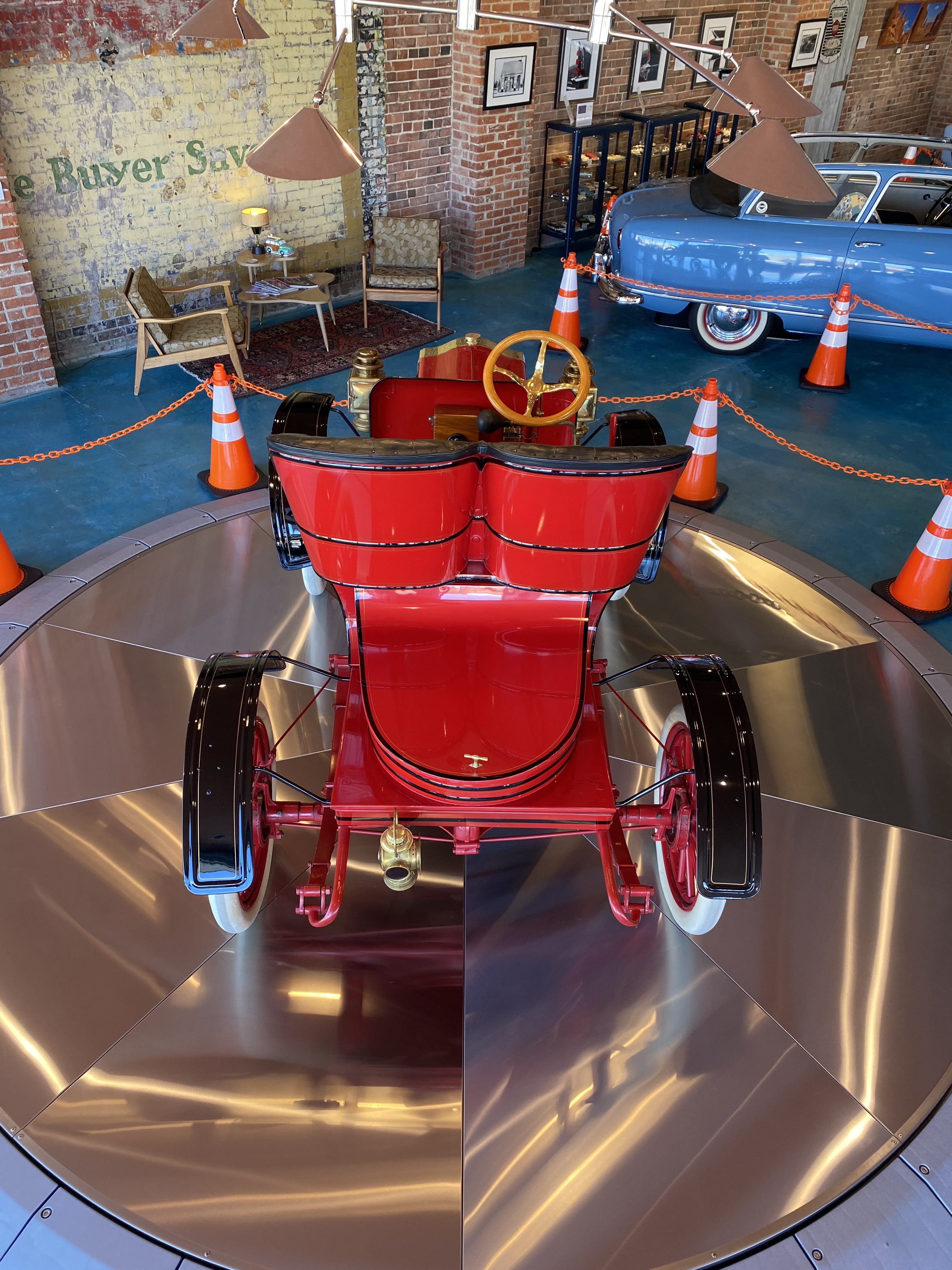
Maxwell-Briscoe was formed in 1904 in North Tarrytown, NY by Benjamin Briscoe & Jonathan Maxwell and their automobiles were built from 1905 to 1913. In 1913, the Maxwell Motor Company was formed and built vehicles until 1925. Walter P. Chrysler joined Maxwell in 1923 and by 1925 the company was merged into Chrysler Motors Corporation. In total, 3,785 Maxwell-Briscoe’s were built for 1907. This Tourabout was sold new in San Francisco and the second owners had it restored in Loveland, CO in 1971. It has a top speed of approximately 20mph.
Forney Museum of Transportation Collection.
Generously donated by Doug & Beverly Knox of Brighton, CO in March 2020.
French Royalty Visits The Orphanage: 1961 Renault Dauphine, on loan from The Forney Museum
January 10, 2021 – April 11, 2021
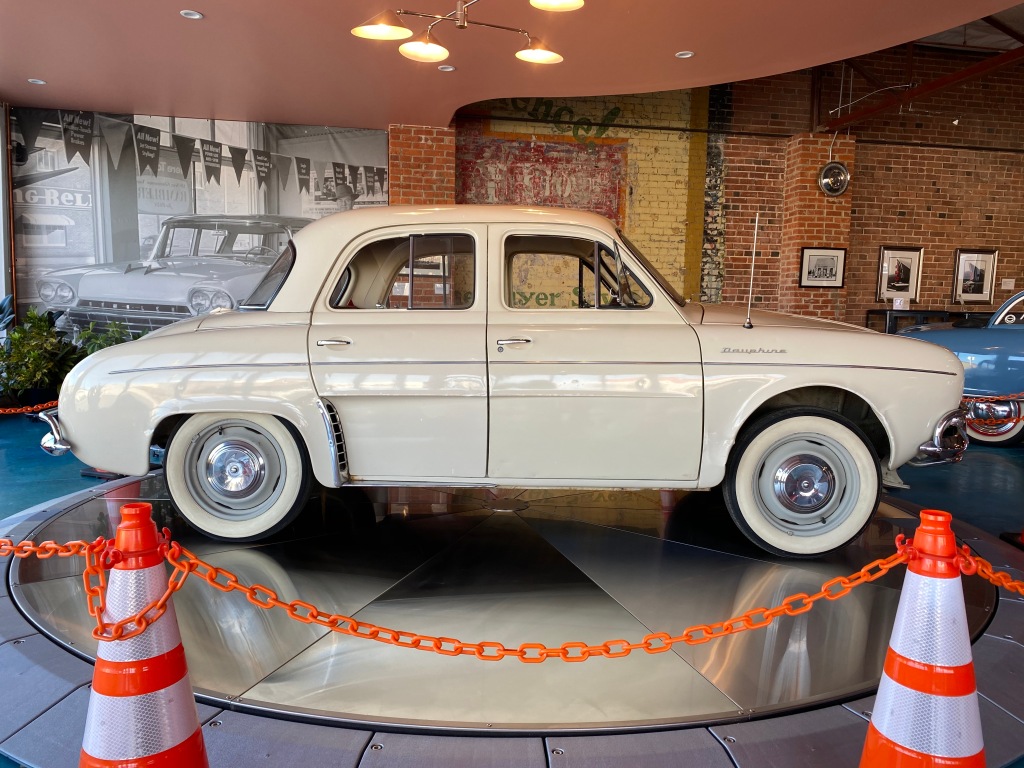
The word Dauphine is defined as the female form of the French feudal title of Dauphin, heir apparent to the French royal crown. High aspiration for the little 1961 Renault Dauphine on loan from Denver’s Forney Museum of Transportation.
A pioneer of the European economy car, this rear engine/rear wheel drive, four-door saloon, manufactured in one body style only, was the successor to the successful Renault 4CV. Several years of secret R&D and thorough testing went into the Dauphine which was introduced in March 1956. More than two million units were manufactured during its 1956-1967 production run.
At 155.0 inches in length and weighing 1430 lb., the Dauphine uses an 845 cc, water cooled, in line four cylinder engine. The engine is rated at 32 hp, with a top speed of 70 mph, 0-60 in 32 seconds. The transmission is a three-speed manual (a four-speed was added later in the production run). Beginning in 1957, an electromagnetically operated clutch with no clutch pedal was offered, much like Volkswagen’s Autostick.
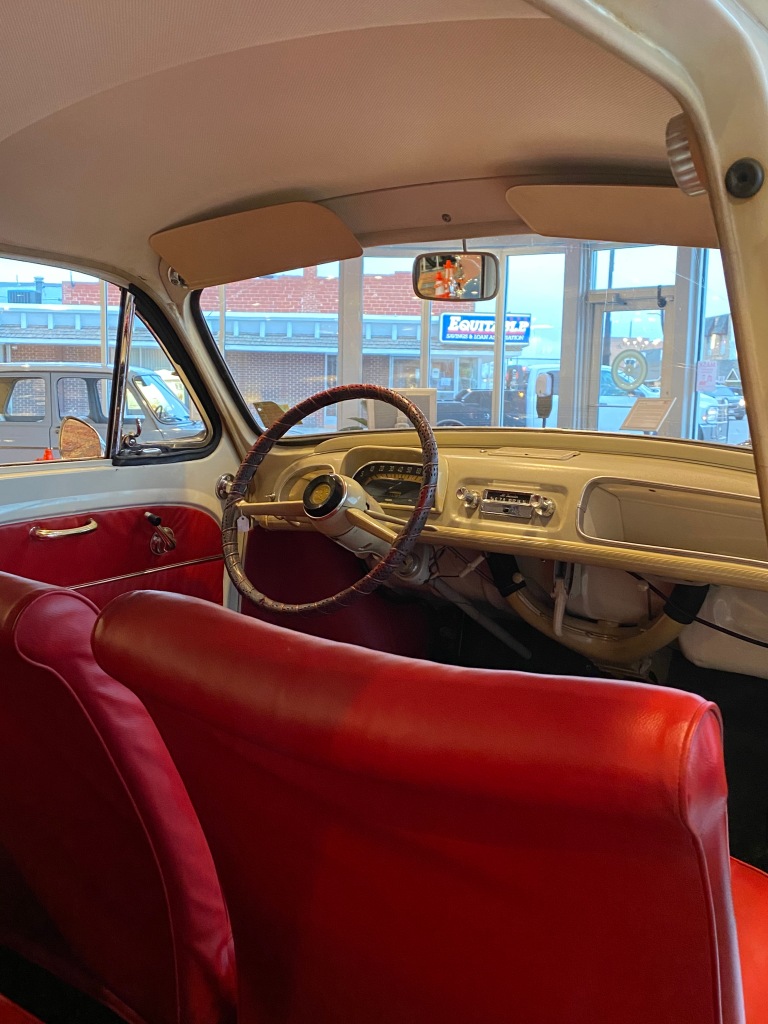
Steering is rack-and-pinion and front suspension is coil spring/twin wishbone layout with an anti-roll bar. Rear suspension is swing axle with coil spring/telescopic dampers sitting atop the swing tubes. More than half of the car’s weight is carried by the rear wheels. This, in combination with the suspension and over-inflated front tires could lead to oversteer characteristics much like the Chevrolet Corvair.
Sheet metal styling assistance was provided by Luigi Segre of Carrozzeria Ghia, an automotive design and coach building firm in Turin, Italy. Segre’s studio also designed the curvaceous VW Karmann-Ghia.
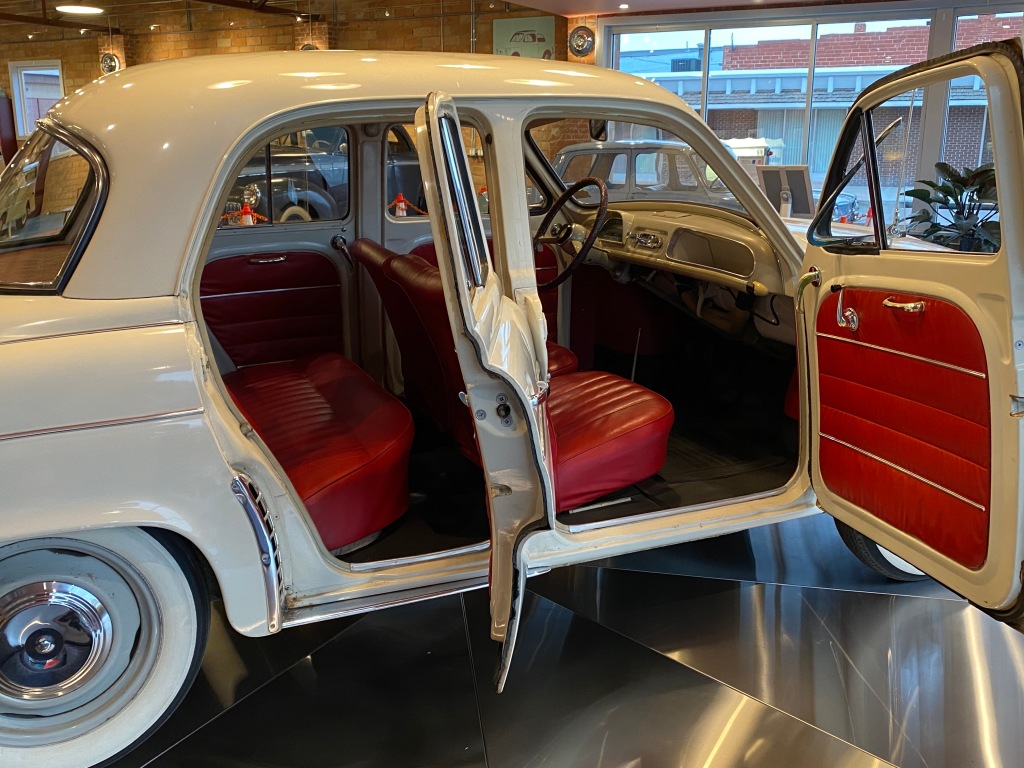
The Dauphine has a front hinged trunk lid with integral headlights. The spare tire is located horizontally, under the front of the car, behind a panel below the bumper. The passenger compartment has bucket seats up front and a rear bench seat, a heater, painted dash (matching the exterior color) with twin open bins on the dashboard, in lieu of gloveboxes, sliding rear windows and twin horns, one for town and one for the country. In addition, rear door safety locks, stainless steel trim moldings and hold-open catches on the door stays were standard.
Award winning Parisian textile artist, Paule Marrot, suggested to Renault’s chairman that she could help find “fresh vibrant colors” to replace the drab automotive colors of postwar Paris. Morrot became a member of the Dauphine team and went on to propose vibrant pastels and complimentary fabrics for seats and door panels.
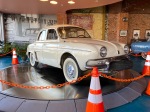
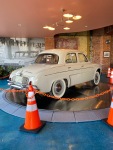
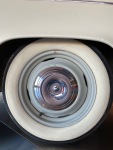
Although the Renault Dauphine was a popular machine around the world, it suffered from many problems including poor reliability and assembly, mechanical problems, and severe rust problems. The Dauphine has been proclaimed the “9th Worst Car of the Millennium” and “truly unencumbered by the engineering process” and yet, the Dauphine was America’s best-selling import car of 1959.
Final Guest Vehicle of 2020:
1932 Plymouth Model PB Sport Roadster Displayed at the Orphanage in Yuma, on Loan from the Forney Museum
October 5 – January 9, 2020
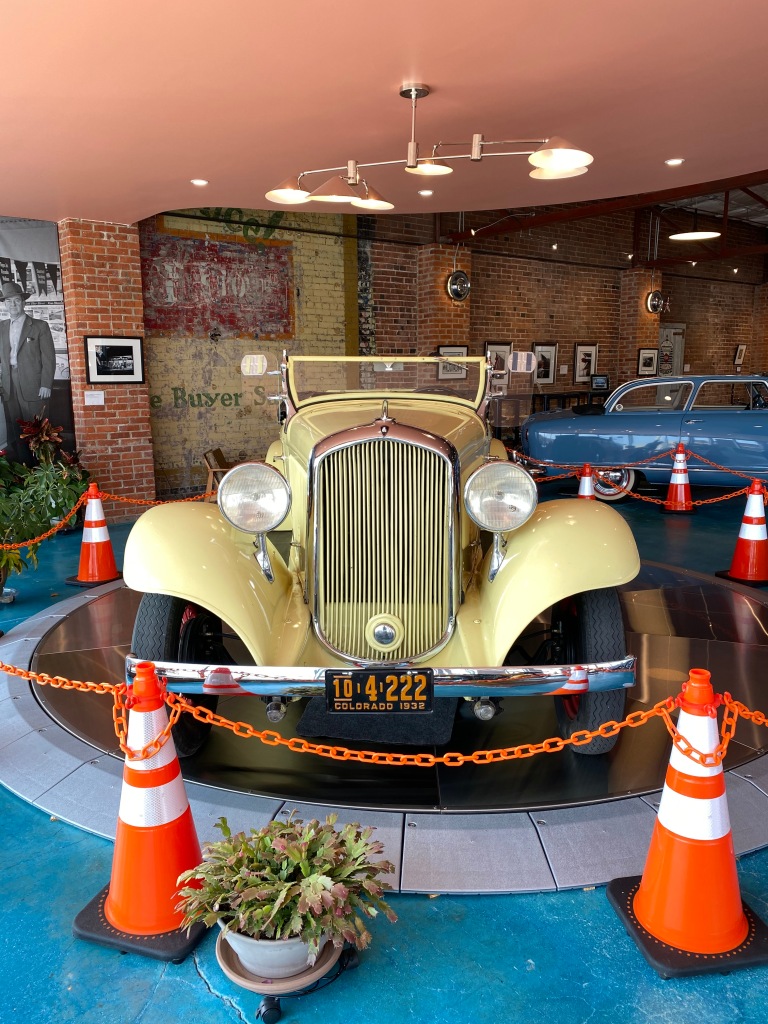
YUMA, COLO – A 1932 Plymouth Model PB Sport Roadster will be on display at the Orphanage from October 5th through the first full week in January. The car is on loan from the Forney Museum in Denver. The Roadster was generously donated to The Forney in 2008.
1928 was a busy year for Walter P. Chrysler. Chrysler launched the Plymouth brand in July 1928, just one month before it launched the DeSoto brand. To top it off, the corporation purchased Dodge the very same year. Plymouth was intended to be the low-price option and was introduced to compete with the lower priced cars produce by Ford and Chevrolet. DeSoto and Dodge were aimed at the mid-priced market. During the Great Depression of the 1930’s, the Plymouth Division ensured the survival of the Chrysler Corporation when other car companies failed. By 1931, Plymouth rose to number three in sales among all cars.
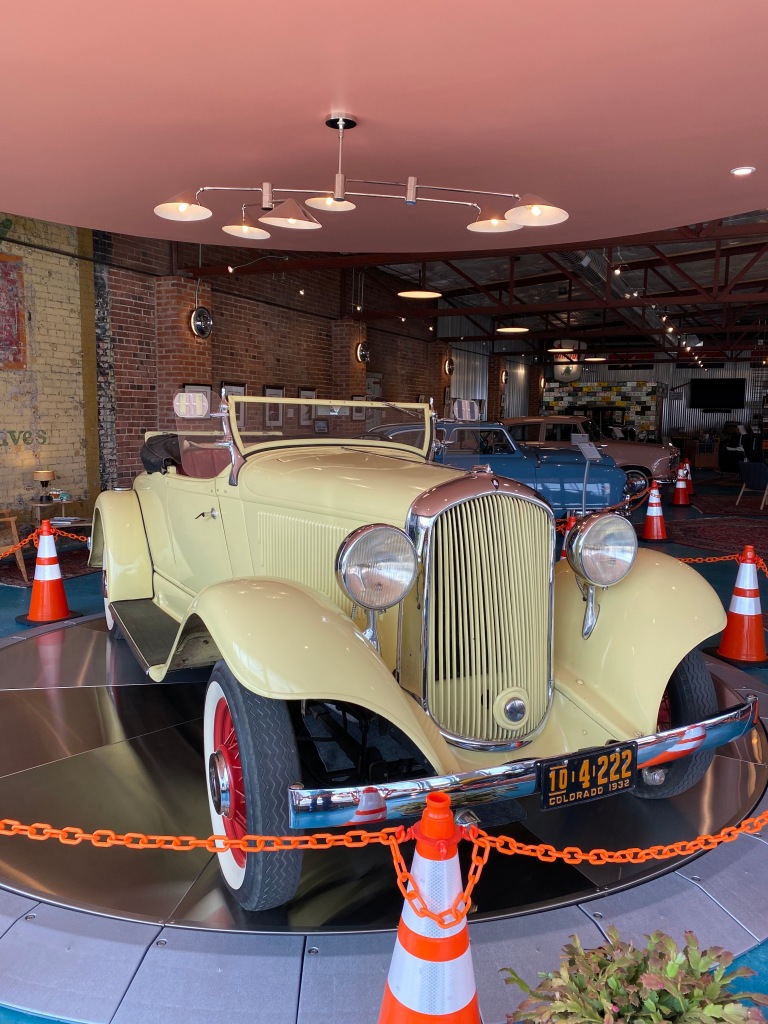
Only slightly higher priced than Chevrolet and Ford, Plymouth was offered with standard features not offered by the competition. Some of these features were hydraulic brakes, full-pressure lubrication, aluminum alloy pistons and an independent hand brake. Chrysler introduce what they called “Floating Power” in 1931, which was rubber coated engine mounts to keep vibration to a minimum.
In 1932, Plymouth increased the Model PB wheelbase to 112 inches, a three inch increase. Horsepower was increased from 56 to 65. The ten model lineup ranged in price from $495 to $795. Plymouth even offered a Collegiate Special Sport Roadster, for $40 extra, which was painted in the buyer’s school colors. 1932 was the last year of the four-cylinder Plymouth line. For 1933, an inline six-cylinder was introduced to compete with Chevrolet’s six-cylinder and Ford’s V8.
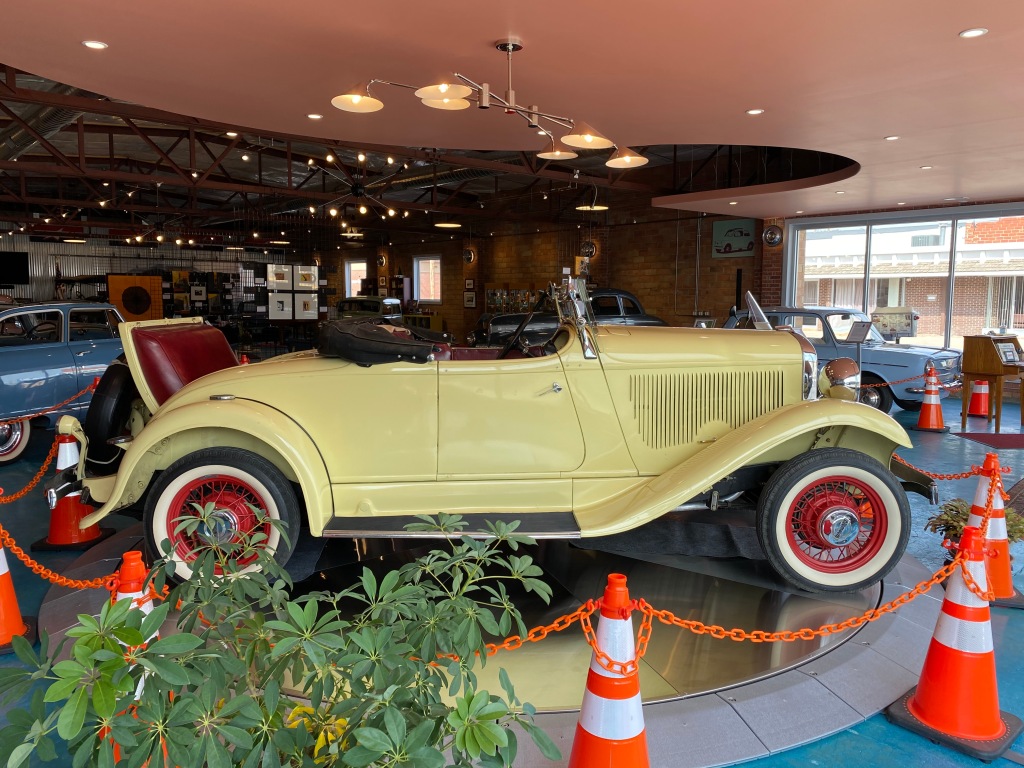
The 1932 Plymouth, Model PB, Sport Roadster on display has the following standard and optional equipment: 4-wheel hydraulic brakes, wire spoke wheels, cowl mounted fresh air vents, under dash mounted hot water heater, twin tail lamps, windshield side wings, rear mounted spare, rumble seat and after-market turn signals.
1964 Flower Power VW Beetle
Sept. 5 – Oct. 4, 2020
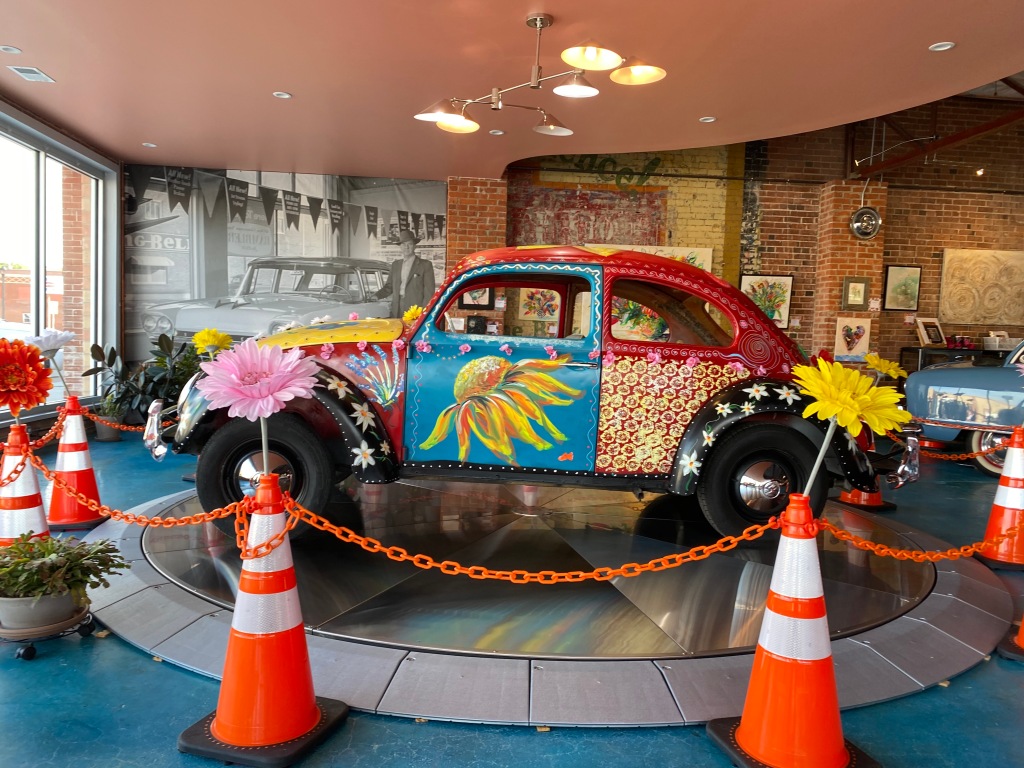
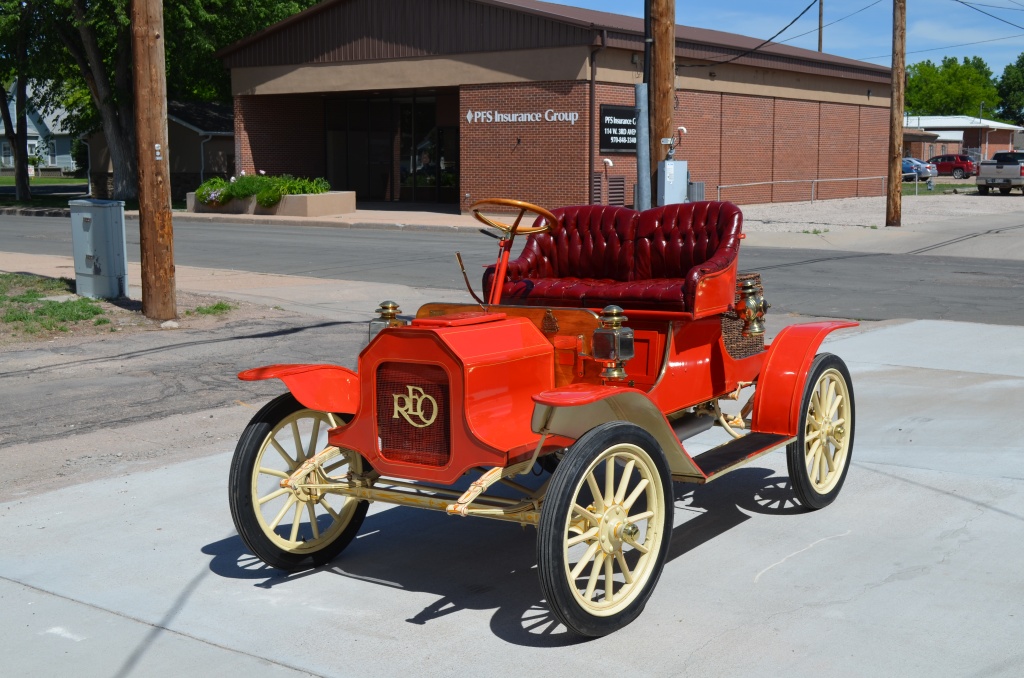
1909 REO Runabout Displayed at the Orphanage in Yuma, on Loan from the Forney Museum
May 31-August 29, 2020
YUMA, COLO – On loan from the Forney Museum of Transportation in Denver, the 1909 REO Runabout on display at the Orphanage is powered by a water-cooled, longitudinal single-cylinder motor mounted beneath the driver seat. Rated at 10 1/2 horsepower and 90 cubic inches, the Runabout reportedly reached a top speed of 26 mph. Lamps and horn were standard equipment at the base price of $500 ($150 less than the Ford Model T), but the windshield and top were extras, $25 and $30, respectively. Weight is 975 pounds.




Messerschmitt Microcar on Loan from Forney Museum
Mid-February – Mid-May
YUMA, COLO – Denver’s Forney Museum of Transportation and The Orphanage, in Yuma, have forged a partnership to expose some of the Forney’s collection to a wider audience in eastern Colorado. Starting mid-February and running through mid-May, The Orphanage will display a 1955 Messerschmitt KR200, on loan from the Forney Museum.

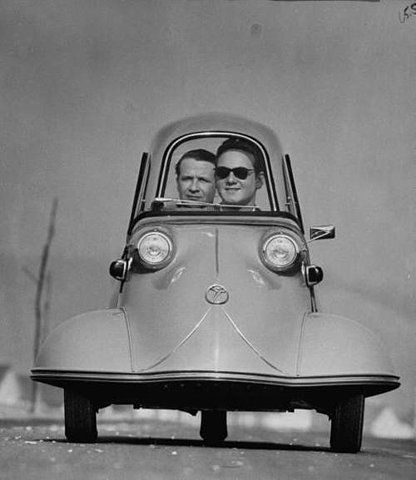
The microcar on display at the Orphanage is a two-seat tandem, three-wheeled “Bubble Car,” designed by aeronautical engineer Fritz Fend to be produced at the Messerschmitt facility, in Regensburg, Germany. Fend first produced the KR175 in the Messerschmitt factory in 1953 and in 1955 it was replaced by the KR200. KR stands for Kabinenroller (cabin scooter). In addition to a larger engine, the KR200 had improved suspension, engine mounting and controls, larger wheels, and a means by which to reverse the car. Reverse was accomplished by reversing the rotation of the engine itself.




Retailing for around DM 2,500 ($595), the KR200 was considered an instant success with almost 12,000 built during its first year. An “Export” package included a two-tone paint scheme, painted hubcaps, a fully trimmed interior, a heater, a clock, and a sunshade for the canopy. The United Kingdom was the manufacturers biggest export destination.
Ford Model TT Fire Truck
YUMA, COLO – The Orphanage, in downtown Yuma, is displaying a restored 1920 Ford Model TT fire truck, the second T stands for Truck, belonging to the Eckley Volunteer Fire Department. Originally owned by the Yuma Volunteer Fire Department, the fire truck on display was sold to the E.V.F.D. in the 1950’s. The TT fire truck will be on display from November 16th through February 15th.
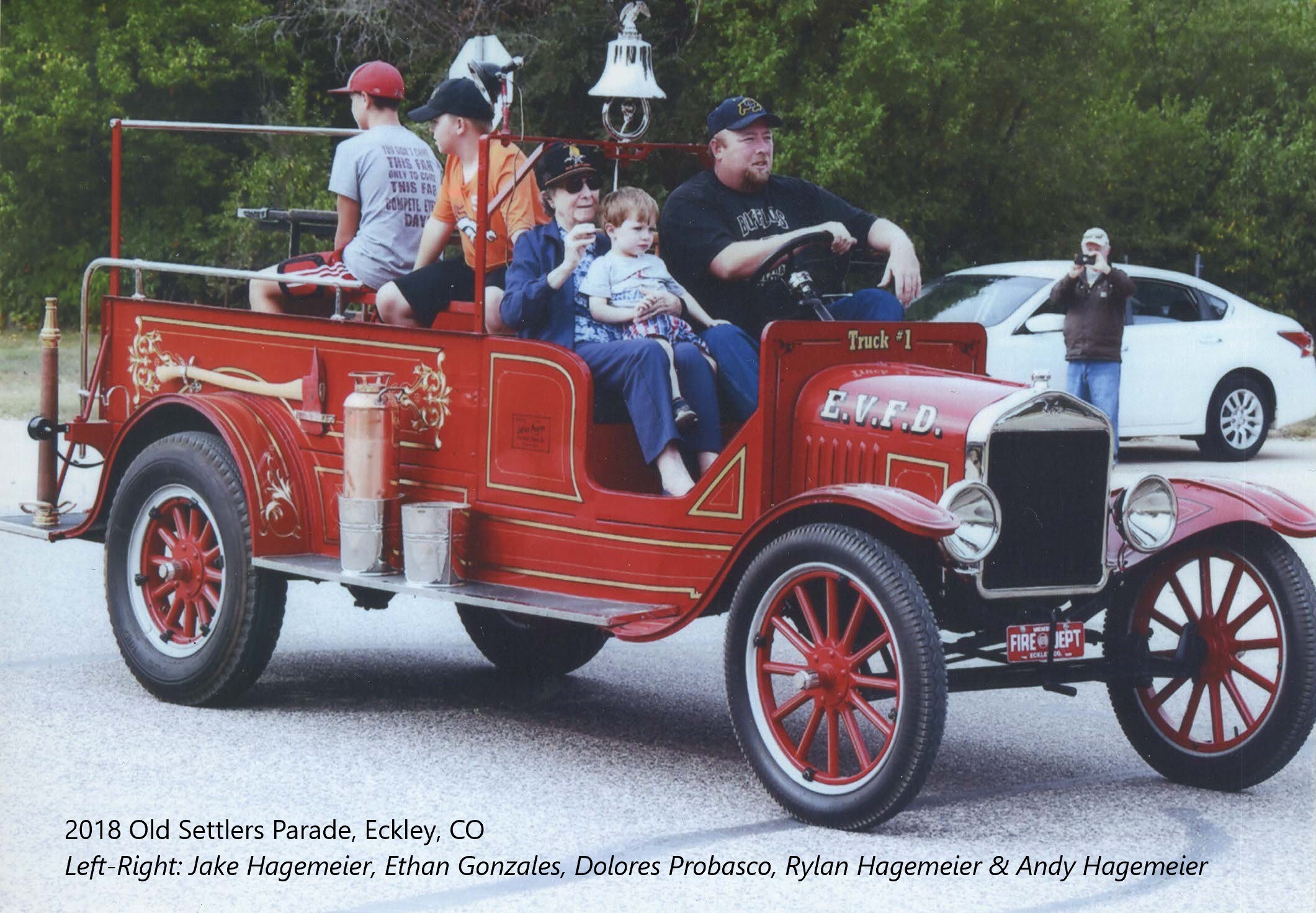
Almost from the beginning of Model T production, the public clamored for commercial chassis on which to build a multitude of working vehicles. Due to its versatility, the T made a suitable platform for fire trucks. First offered in 1911, but not officially considered in production until 1914, Ford started selling stripped down chassis. They were stripped of all bodywork except for the cowl, engine cover, radiator, front fenders and headlamps. Customers would take these rolling chassis to independent body makers to create custom bodies that suited the customer’s needs.
Rural fire departments with modest budgets appreciated the Ford chassis’ reasonable price, low operating cost and easy maintenance. In 1917, in anticipation of Chevrolet and Dodge producing truck chassis, Ford decided to produce a commercial chassis with a stretched wheelbase. The Model TT was based on the T but with a rear axle worm gear, heavier frame & rear axle, and it would carry a payload of 1 ton. The TT sold for $600 and in 1920 almost 54,000 commercial chassis were sold.
Specifications for the Model TT chassis are as follows: 125” wheelbase, compared to the Model T at 100”. The engine size is 177 cu. in. producing 20 hp., and with standard gearing, 15 mph was the recommended top speed. Transmission is a two-speed planetary type. Suspension is via transverse, semi elliptical springs both front and rear and the wheels are wood artillery wheels. Ignition is a magneto type.
This E.V.F.D. fire truck sports a body provided by the Julius Pearse Fire Department Supply Company of Denver, CO. Julius Pearse was one of the organizers of the original volunteer fire department of Denver, an organizer of the Colorado State Fire Association and, in the late 1800’s, a pioneer fire chief of the city of Denver. Later in life, he formed the Julius Pearse Fire Department Supply Company which supplied all manner of fire-fighting equipment in addition to custom bodies for commercial chassis.
The E.V.F.D team for this ten-year restoration was Andy Hagemeier, Tony Probasco and Tim Probasco. Mechanical restoration and paint by Chapman Custom Auto, Edison, NE, stripes and graphics by Hot Brush, Bird City, KS and plating by Quality Plating, Yuma, CO. Paint was donated by Todd A. Wendt. The restoration project was completed in August 2018.




1940 International Farmall A – This tractor was restored by Ramon O. Hernandez in 2013. Bill Wenger presented it to his wife Marie on her birthday in 2013. The “A” occupied a place of honor on the turntable at The Orphanage during Marie’s birthday party, October 6, 2018.



